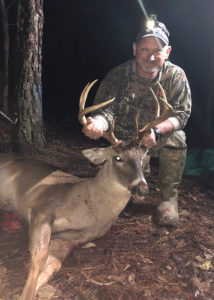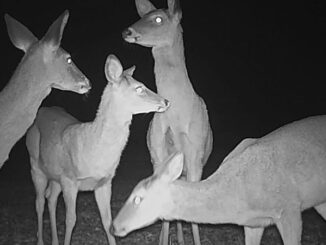
What does the season hold for public- and private-land hunters in the Pineville Region who pursue deer, ducks and small-game species this fall and winter?
LDWF biologists, hunters and others have been working, readying public and DMAP private lands for the 2020-21 hunting seasons for big game, small game, ducks, doves and woodcock. Overall, the preseason has been fair to good as far as habitat conditions, food supply and the health of wildlife on DMAP private lands and WMAs.
Before hunting this season, check out the 2020-21 hunting seasons, rules and regulations approved in May by the Louisiana Wildlife and Fisheries Commission at www.wlf.louisiana.gov/page/seasons-and-regulations. Hunters are urged to contact their local LDWF field office for assistance or clarifications of seasons, rules or regulations at www.wlf.louisiana.gov/page/contact-us.
The deadline to apply for lottery deer hunts is Aug. 31; the deadline to apply for lottery waterfowl hunts is Sept. 30. Also, lottery hunts for deer and waterfowl are scheduled for outdoorsmen and outdoorswomen with disabilities on select WMAs. And lottery hunts for deer and waterfowl will be held for boys and girls between ages 10 and 17 on select WMAs. A youth under 10 may apply, provided he or she will be 10 on or before the date of the prospective hunt. All lottery applications are available https://la-web.s3licensing.com/.
Pineville Region
Cliff Dailey, a LDWF biologist is looking forward to the fall and winter as much as or more than hundreds of hunters.
They are keeping a close eye on some public areas impacted by spring flooding. Dewey Wills WMA in the lower part of LaSalle and Catahoula parishes in central Louisiana was one of those areas. All roads closed due to backwater flooding were reopened in June, according to LDWF.
How the table is being set
On DMAP private lands, the preseason has been encouraging after ample spring rainfall made everything brush up, according to Benjamin Holton, private-lands biologist supervisor. Catahoula Parish lands stayed flooded a lot longer than others, and parts of LaSalle Parish experienced some flooding near big bodies of water, but the high water receded in both parishes before the onset of summer.
 On WMAs, it’s a little disconcerting that 90% of Dewey Wills has undergone major flooding this past spring, which results in deer browse conditions not being up to snuff entering mid-summer, Dailey reported. Bottomland hardwood timber there has been stressed by the high water, and there is the potential for disease in some areas.
On WMAs, it’s a little disconcerting that 90% of Dewey Wills has undergone major flooding this past spring, which results in deer browse conditions not being up to snuff entering mid-summer, Dailey reported. Bottomland hardwood timber there has been stressed by the high water, and there is the potential for disease in some areas.
Overall deer outlook
On DMAP and private lands, Holton said landowners, deer hunters and managers have been working with LDWF to get ready. The deer reportedly have responded in many areas.
 For WMAs, Dailey rates Camp Beauregard an 8 out of 10; Sabine a 7; Dewey Wills a 6; Alexander State Forest a 4, and Little River a 3. At Camp Beauregard, habitat conditions are favorable because of routine harvesting of pine plantations, according to Dailey.
For WMAs, Dailey rates Camp Beauregard an 8 out of 10; Sabine a 7; Dewey Wills a 6; Alexander State Forest a 4, and Little River a 3. At Camp Beauregard, habitat conditions are favorable because of routine harvesting of pine plantations, according to Dailey.
Prescribed burns have been conducted on various pine stands. Also, lactation rates on mature does were good. At Dewey Wills, the mast crop was above average. The deer herd was in physical condition, including does within the desired range of the lactating process.
Quality deer outlook
For WMAs, Dailey rates Dewey Wills and Camp Beauregard as 8s; Sabine a 7, and Alexander State Forest and Little River 4s. Camp Beauregard’s success rate on quality deer during Thanksgiving managed hunts is among the best on any WMA in Louisiana.

Why? It has a mix of upland pine areas and lower, creek-bottom hardwood areas, as well as water oak and white oak abundant throughout to provide a highly sought-after food source in fall/winter. Spring rains and open canopy combined to create prime habitat.
Dewey Wills features many acres of well-managed upland pine with bottom hardwood creek bottoms. What’s more, old, dying trees combined with timber harvesting have created canopy gaps that make “briar thickets” for the deer to use. The food’s there, too. Nuttall, willow and overcup oak provide fall mast for the deer and squirrels.
Duck hunting outlook
 The region’s top WMA duck-hunting destination continues to be Dewey Wills. According to Dailey’s latest report, 2,999 ducks were harvested on Dewey Wills last season. Many came from an impoundment north of the Diversion Canal between Hunt Road and Louisiana 28 East, a 3,000-acre area designed to flood the Muddy Bayou watershed. An average to above-average season is forecast there, dependent on the fall flight. Another prime duck-hunting area covers the backwaters of the Little River WMA, where 229 ducks were killed last season.
The region’s top WMA duck-hunting destination continues to be Dewey Wills. According to Dailey’s latest report, 2,999 ducks were harvested on Dewey Wills last season. Many came from an impoundment north of the Diversion Canal between Hunt Road and Louisiana 28 East, a 3,000-acre area designed to flood the Muddy Bayou watershed. An average to above-average season is forecast there, dependent on the fall flight. Another prime duck-hunting area covers the backwaters of the Little River WMA, where 229 ducks were killed last season.
Squirrel hunting outlook
It’s hard to beat Dewey Wills WMA, one of the top squirrel-producing areas in Louisiana, where camping and squirrel hunting on opening weekend draws hundreds of hunters. To avoid the maddening crowd, go on weekdays early in the season. Last season was a banner season, when 4,168 squirrels were reported harvested. Dailey reported the past two mast crops were above average, which is good news for the upcoming season. However, the squirrel population may be impacted by prolonged flooding on the 63,901-acre area earlier this year.
Little River WMA offers fair to good squirrel hunting in its own right. Last season, 372 squirrels were taken on the area of upland pine and bottomland hardwoods. Most participation is opening weekend when hunters camp. Otherwise, there is some great squirrel hunting with little competition.
Rabbit hunting outlook

Sabine WMA, Camp Beauregard WMA and Little River WMA are shaping up to offer fair to good opportunities to bag rabbits in 2020-21. Sabine has clear-cuts in several areas that have been replanted and currently provide good rabbit habitat and food. Also, the pine plantations have been thinned, thus producing browse and cover. Camp Beauregard WMA also features several replanted clear-cuts offering prime habitat and plenty of groceries. Little River WMA has a good rabbit population in the thinned pine that has been burned in recent years and grow excellent ground level food such as greenbrier and dewberry. Old pine tops also provide welcome cover for the hares.


